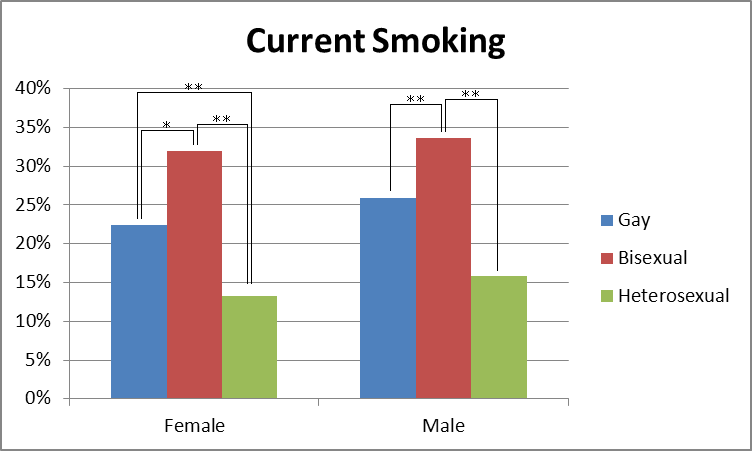In a previous edition of The DRAM, we reviewed evidence suggesting that lesbian, gay and bisexual (LGB) populations have higher rates of alcohol use disorders than their heterosexual counterparts, especially in states with same-sex marriage bans. Studies have also shown higher rates of smoking in gay and bisexual populations (e.g. Lee et al., 2009). Higher rates of smoking and alcohol use in this group could be due to elevated rates of mental health issues stemming from discrimination and stigmatization. However, previous studies have failed to study differences within LGB subgroups. It is possible that certain subgroups might be at higher risks than others. This week’s ASHES reviews a study exploring smoking characteristics of LGB subgroups and heterosexuals in a large, nationally representative sample (Fallin et al., 2014).
Methods
- The authors analyzed data from the 2009-2010 National Adult Tobacco Survey (NATS).
- They identified respondents’ sexual orientation, current smoking status, desire to quit among current smokers, and tobacco advertising receptivity, among other behaviors.
- They defined tobacco advertising receptivity as a binary measure of whether espondents answered “somewhat” or “very likely” to the question: “How likely is it that you would ever use or wear something – such as a lighter, t-shirt, hat, or sunglasses – that has a tobacco company name or picture on it?”
- They excluded transgender individuals due to limited sample size.
- The authors compared these measures between gay/lesbian, bisexual, and heterosexual adults.
- They made separate comparisons for male and female respondents.
Results
- As Figure 1a shows, gay and bisexual men and women were more likely to smoke than their heterosexual counterparts. Bisexual men and women had the highest rates of current smoking, significantly higher than gay or heterosexual men and women.
Figure 1a: Percent of respondents who currently smoke, as a function of gender and sexual orientation. Adapted from Fellin et al., 2014. Note: * Difference between included groups is significant at p < .01. ** Difference is significant at p < 0.001. Click image to enlarge.
- Sexual orientation was also closely linked with receptivity to tobacco advertisements (Figure 1b).
- Bisexual women were the most receptive to tobacco advertising compared to other women, while lesbians were also more receptive to advertising than heterosexual women.
- Bisexual men were more receptive to tobacco advertising than other men. However, gay and heterosexual men were equally receptive to tobacco advertising.
Figure 2b: Percent of respondents deemed receptive to tobacco advertising, as a function of gender and sexual orientation. Adapted from Fellin et al., 2014. Note: * Difference between included groups is significant at p < .01. ** Difference is significant at p < 0.001. Click image to enlarge.
- The studied groups were equally likely to report wanting to quit smoking; most (58%-67%) of those who smoked expressed a desire to quit smoking for good.
Limitations
- The NATS gender question may be too restrictive for categorizing sexual orientation, as individuals might identify as something other than heterosexual, gay or lesbian, or bisexual.
- Additionally, transgender identity and sexual orientation are combined into a single question, possibly causing inaccurate reporting for transgender individuals.
Conclusion
Sexual minorities smoke at higher rates and are more receptive to tobacco advertising, while showing similar desire to quit as their heterosexual counterparts. Additionally, bisexuals in particular seem to show higher rates even when compared to the gay subgroup. These differences suggest that smoking cessation efforts could be targeted at specific subgroups rather than the LGB population as a homogeneous group. Further research could also focus on understanding why bisexual individuals might be more susceptive to tobacco advertising.
– Jed Jeng
What do you think? Please use the comment link below to provide feedback on this article.
References
Lee, J. G., Griffin, G. K., & Melvin, C. L. (2009). Tobacco use among sexual minorities, USA, 1987-2007 (May): A Systematic Review. Tobacco Control, tc-2008.






